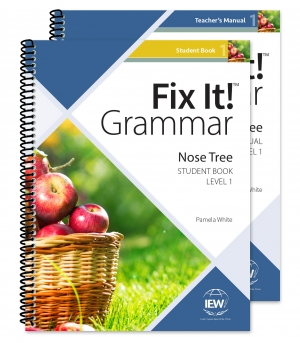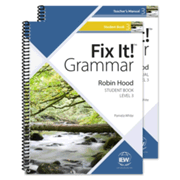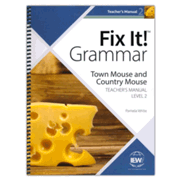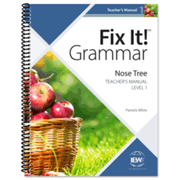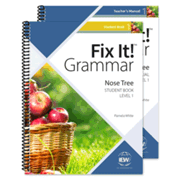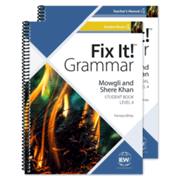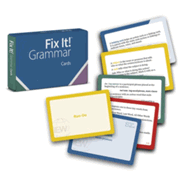Fix It!™ Grammar can serve as your primary source of grammar instruction while also developing students’ vocabulary and writing skills. The series makes a perfect companion for IEW's Structure and Style for Students since it applies terminology and strategies from that course. The terminology is explained well enough in the Fix It! courses that using Structure and Style for Students is not required. However, it makes sense to use both together if possible. And Fix It! doesn't require much time—usually no more than 15 minutes a day.
The six courses in the Fix It! Grammar series can be used with students in grades four through twelve. This review is for the fourth editions (2022) of the courses.
Each course has two essential components: a teacher’s manual and a student book. All of the books are spiral bound which allows them to lie flat—a big help for students who will be writing in their books. An optional set of grammar cards can be purchased separately. The information on the grammar cards is in a glossary at the back of each teacher’s manual, but you might prefer that students have their own set of cards. (The same set of grammar cards is used for all six courses.)
Each Fix It! Grammar course is based upon a fictional story that has been significantly abridged and rewritten. The six courses and their recommended grade levels are:
- Nose Tree - Level 1, grades 4-5
- Town Mouse and Country Mouse - Level 2, grades 4-5
- Robin Hood - Level 3, grades 6-8
- Mowgli and Shere Khan - Level 4, grades 6-8
- Frog Prince - Level 5, grades 9-12
- Little Mermaid - Level 6, grades 9-12 (due in the fall of 2022)
The courses gradually increase in difficulty. They should be used in order, but older students can begin in the middle of the series if they have already studied grammar. Free samples from each of the course books can help you decide which level to select. If you start with a course beyond Level 1, you will need to spend some time at the beginning teaching students the mark-up system used by Fix It! and reviewing any elements of the previous grammar instruction that are not familiar. It's usually easier to just begin with Nose Tree.
How it Works
In each course, the fictional story is told with only one or a few sentences per day for four days per week for 30 weeks. The humor and fantasy in the fictional stories are likely to appeal to most students. However, it is important to recognize that these are not the original versions of the stories, and the language has been adapted to suit the purposes of these courses with simpler sentence structures than in the originals and the substitution of more appropriate vocabulary words.
Each day, students work with the selected passage from the story. They define the bolded vocabulary word; make grammar, punctuation, usage, and spelling corrections; identify parts of speech, phrases, and clauses; and work with dress-ups (e.g., adverbs ending with -ly and clauses that begin with because), sentence openers, and other style elements as taught in Structure and Style for Students. Students recopy each passage once they’ve fixed it. While a vocabulary word is included each day, the number of other elements varies. Level 1 requires students to make far fewer corrections or improvements than do the courses for older students.
The process is summarized with the sequence: Learn It!, Read It!, Mark It!, Fix It!, and Rewrite It!. In the student workbook, this process is spelled out under these five headings and walks students through the four lessons for each week.
The Learn It! instruction is only presented on the first of the four days, usually on its own page. Read It!, Mark It!, and Fix It! assignments for each day are listed at the top of the student’s worksheets for either three or four days. The sentence or sentences to be edited are in the center of the page, and the Rewrite It! section at the bottom has lines for students to copy the corrected passage.
Learn It! is where new concepts are explained in both the student books and teacher’s manuals. Even though students can read it for themselves, parents or teachers should go over the concepts with them so that students clearly understand what they are to do. For example, Nose Tree teaches about adjectives in Week 7 (p. 37). The student book explains what an adjective is and gives students a method to use to determine whether a word is an adjective. Then it provides an example showing how adjectives are to be marked in a sentence. Students will then be asked to identify adjectives in some of the sentences from that point on. The parent or teacher should work with the student through the Learn It! section, helping them identify adjectives in the first passage where they appear and providing additional help until the student is able to easily identify most adjectives.
Under Read It!, students use a dictionary to look up the bolded vocabulary word (from the story passage), choose the definition that fits the context in which the word appears, and write the word and its definition. Some of the student books have enough white space for writing the word and its definition on that day’s page, but there is no designated space for it. It might be best for students to compile their glossary of vocabulary words in a separate notebook. It's important to note that the fourth editions of Fix It! were rewritten to make the vocabulary words more appropriate for each level.
Mark It! lists the specific items (and how many of each) that students are to identify in the passage. For instance, they might be told to identify three nouns, two pronouns, and one prepositional phrase. (This is a big improvement over the third editions of the courses that simply listed things for students to look for without specifying how many—or even if any—were actually there.)
Fix It! also lists the number, but this time it shows how many of each type of fix are needed for capitalization, specific types of punctuation, and usage, and occasionally for other elements, such as indentation and pronoun antecedents. For example, it might tell students to fix three capitals and one end mark (i.e., end-of-sentence punctuation).
After students have made all of their corrections and reviewed them with a parent or teacher, they are to rewrite the passage in the Rewrite It! section.
Fix It! Grammar requires both independent and interactive work. Once students understand the process, they can sometimes correct and mark up the passage for the day on their own, and they should be able to do vocabulary work and the rewrites on their own. High school students might be able to complete a week’s work before checking with a parent or teacher, and younger students who have a good grasp of grammar might do much of their work independently as well.
The exercises are teaching tools, so the author encourages parents and teachers to treat lessons like puzzles or detective games rather than exercises to be graded. Students will be exposed to concepts over and over again, so they will learn eventually, even if they struggle with a concept at first.
The teacher’s manuals have completely marked-up sentences for easy reference. Below each day’s correctly marked-up sentence, the teacher also has detailed notes and explanations for all Mark It! and Fix It! items.
Most of the courses add an extra Review It! page at the end of the week’s lesson beginning with Week 24. (Level 3 inserts one earlier than Week 24 and doesn’t include one for the last few weeks.) Review It! might require students to respond orally, provide written responses in their book, or just read through the review material.
As I mentioned earlier, the books get progressively more difficult, building upon one another in sequence. For example, Nose Tree - Level 1 teaches basic parts of speech but limits pronoun instruction to only those used as the subject of a sentence. In Robin Hood - Level 3, students learn about five types of pronouns: personal, subject, indefinite, demonstrative, and reflexive. Similarly, students gradually learn to identify different types of clauses and stylistic techniques used to construct sentences.
Editing work begins at a simple level in the first book and becomes increasingly challenging so that students are doing advanced editing in Level 6. Consequently, the emphasis shifts away from identifying basic parts of speech and simple punctuation as students do more-comprehensive editing. Students also learn to identify elements of writing style that help them improve composition skills through their knowledge of grammar. For instance, using IEW terminology, the courses have students identify “ly-Adverbs, “Subject Openers,” and other elements within the story passages. These stylistic elements are also added gradually to the courses.
Summary
Fix It! Grammar courses teach grammar through immediate application—they teach students what they need to know at the moment, and they also teach students to think like editors. This approach means that students completing Fix It! Grammar courses are likely to learn grammar and its practical applications more thoroughly than with traditional programs.




